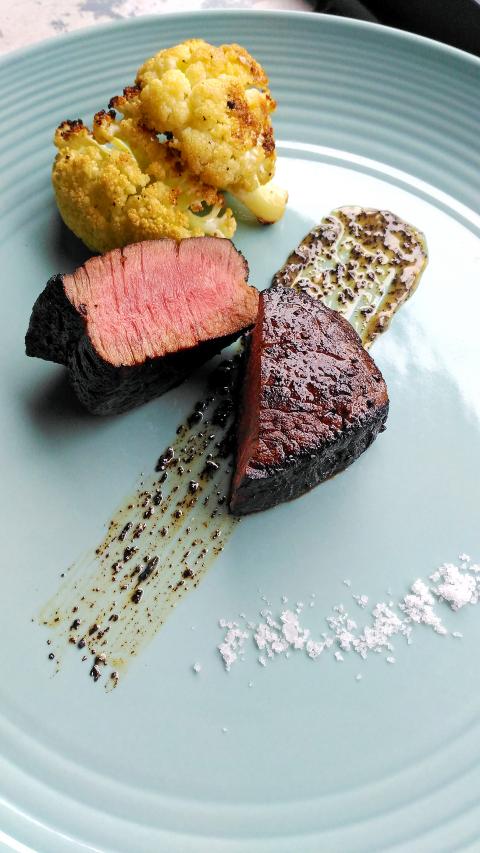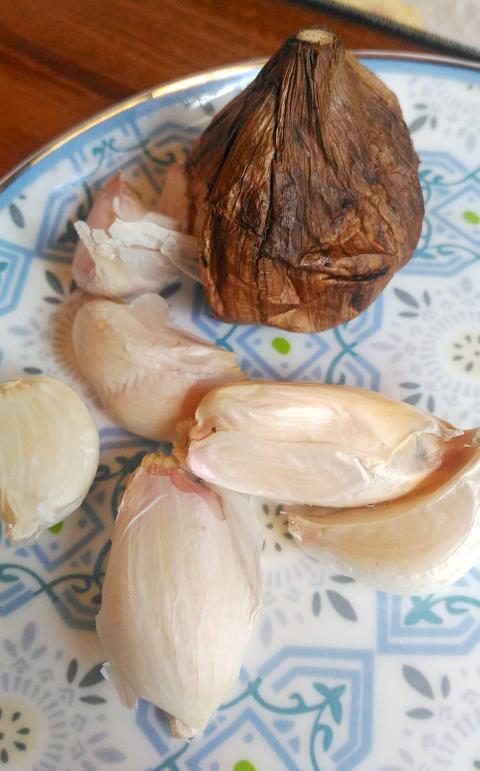Everyone loves garlic, right? Well, some people are not so partial to it. I know and understand this. Sadly, my nine-year-daughter is going through a phase of disliking garlic and it drives me crazy with affronted chef syndrome. Yet garlic is nothing if not endlessly versatile, and recently garlic in a new form has been making its appearance in restaurants and specialist food markets. This is black garlic.
Black garlic has a long history, though there seems to be considerable uncertainty about its actual providence. Many sources suggest that it comes from Korea, which certainly has a long tradition of pickling and fermenting, lending this theory credence.
The smell of garlic frying in olive oil is one of the most awesome smells to grace a kitchen, and this is a gift given to the cook even before the real business of getting lunch on the table begins. Garlic can be used in so many ways and is a foundation of cooking in all the great cuisines of the world. Chinese, French, Italian and Middle Eastern cooks all reach for garlic at the first opportunity. But this is not the case the world over. Anglo Saxons have historically had an aversion to garlic, and prior to the last couple of decades, garlic consumption was often associated sneeringly with southern Europe and Latin cultures. Of course, both these cultural and culinary regions have now risen to worldwide popularity and the sneer has a decidedly grudging quality.

Photo: Ian Bartholomew
My own father, a Briton of the old school, was endlessly fond of regaling family and friends with accounts of his one, not to be repeated, experience with a Greek dentist. In the close quarters of a deep examination of molars, the aromatic intimacy advertised the dentist’s food preferences in a rather too strident manner for comfort. For many non-garlic lovers, this rather imperious disregard for olfactory sensitivities can be a problem. But all is not lost.
Black garlic gets around all these problems, as the bulb develops a completely different flavor through the slow process of curing. It is also said to enhance the already considerable health benefits of regular garlic and offer some of its own unique qualities. Not least, it has greatly enhanced levels of amino acids, that seem to be good for almost every aspect of human health.
Of course, black garlic is quite expensive, reflecting the long and quite complex process of production, but its concentrated flavor allows it to make a huge impact on flavor even when used in relatively small quantities. Many sources refer to black garlic as being fermented, but this is misleading as it is not produced through microbial action but by a slow curing process that requires an extended period, measured in weeks, “cooking” in a temperature and humidity controlled environment. Some sources on the Internet suggest that making black garlic at home is easy, recommending that if you can keep whole heats of fresh garlic at about 60c degrees for four weeks (without it drying out) then you are good to go with a cheap source of black garlic (but this isn’t quite as easy as it sounds and there is a pretty good reason why you can expect to pay around NT$1,000 for five or six heads of good quality black garlic).

Photo: Ian Bartholomew
The blackness is a product of the Maillard reaction, the same process that takes place when we brown meat to draw out the sweetness and flavor. Some people describe black garlic as “caramelized” garlic, and this has appealing suggestions of black garlic’s intense earthy sweetness, with its hints of sauteed mushrooms, dried fruit, rich earth and savory jam.
Black garlic has been around for quite some time on the fringes of herbal medicine, sought after for its concentrated antioxidant effects and other supposed benefits. In the late aughts, it was taken up by a number of high profile chefs and now is beginning to enter the culinary mainstream and is produced around the world. Taiwan produces good quality black garlic, though it is instructive that it still mainly retails as a health supplement. It keeps well in the fridge and so can be kept on hand to give all sorts of dishes a flavor boost.
Beef tenderloin with black garlic butter
Recipe
(serves two)
Garlic can be used in so many ways. From raw garlic to slices gently simmered in olive oil or butter, to garlic pulverized in salt and herbs, it enters everything from salads to stir-fries. This dish uses garlic in a different form, garlic that is treated by long slow cooking until it turns black. The slow process of drying and cooking the garlic at very low heat brings out incredible earthy flavors that at their best rival truffle and other top-end fungi. In Taiwan, I have seen black garlic sold primarily for its health benefits, which are said to be numerous, but that is without doubt only a secondary reason for trying it out. The first is, of course, flavor.
INGREDIENTS
two tenderloin steaks (about 200g each)
salt and pepper to season
olive oil
four cloves black garlic, room temperature
30g butter, room temperature
pinch of sea salt
Directions
1. Trim any remaining tendon and membrane from the tenderloin.
2. Rub generously with salt, pepper and olive oil.
3. Place in a preheated oven at 100c for about 30 minutes or until internal temperature reaches 42c. Turn once.
4. Meanwhile, mash the butter and black garlic together adding salt to taste. A little olive oil can be added to the mix to smooth it out, though this is strictly optional.
5. Heat a stainless steel or cast iron skillet until almost smoking then place the steaks on the hot surface to sear for two minutes each side. Bring internal temperature to about 52c to 56c depending on how you like your meat cooked.
6. Rest the beef for at least five minutes before serving. Serve with a generous smear of black garlic butter and some course sea salt.
Ian Bartholomew runs Ian’s Table, a small guesthouse in Hualien. He has lived in Taiwan for many years writing about the food scene and has decided that until you look at farming, you know nothing about the food you eat. He can be contacted at Hualien202@gmail.com.

May 11 to May 18 The original Taichung Railway Station was long thought to have been completely razed. Opening on May 15, 1905, the one-story wooden structure soon outgrew its purpose and was replaced in 1917 by a grandiose, Western-style station. During construction on the third-generation station in 2017, workers discovered the service pit for the original station’s locomotive depot. A year later, a small wooden building on site was determined by historians to be the first stationmaster’s office, built around 1908. With these findings, the Taichung Railway Station Cultural Park now boasts that it has

Wooden houses wedged between concrete, crumbling brick facades with roofs gaping to the sky, and tiled art deco buildings down narrow alleyways: Taichung Central District’s (中區) aging architecture reveals both the allure and reality of the old downtown. From Indigenous settlement to capital under Qing Dynasty rule through to Japanese colonization, Taichung’s Central District holds a long and layered history. The bygone beauty of its streets once earned it the nickname “Little Kyoto.” Since the late eighties, however, the shifting of economic and government centers westward signaled a gradual decline in the area’s evolving fortunes. With the regeneration of the once

The latest Formosa poll released at the end of last month shows confidence in President William Lai (賴清德) plunged 8.1 percent, while satisfaction with the Lai administration fared worse with a drop of 8.5 percent. Those lacking confidence in Lai jumped by 6 percent and dissatisfaction in his administration spiked up 6.7 percent. Confidence in Lai is still strong at 48.6 percent, compared to 43 percent lacking confidence — but this is his worst result overall since he took office. For the first time, dissatisfaction with his administration surpassed satisfaction, 47.3 to 47.1 percent. Though statistically a tie, for most

In February of this year the Taipei Times reported on the visit of Lienchiang County Commissioner Wang Chung-ming (王忠銘) of the Chinese Nationalist Party (KMT) and a delegation to a lantern festival in Fuzhou’s Mawei District in Fujian Province. “Today, Mawei and Matsu jointly marked the lantern festival,” Wang was quoted as saying, adding that both sides “being of one people,” is a cause for joy. Wang was passing around a common claim of officials of the People’s Republic of China (PRC) and the PRC’s allies and supporters in Taiwan — KMT and the Taiwan People’s Party — and elsewhere: Taiwan and